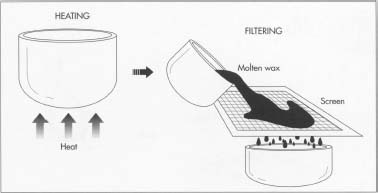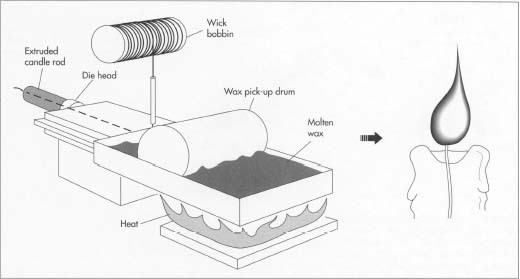Candle
Background
One of the earliest forms of portable illumination, candles have served vital functions for humankind throughout history, a fact chronicled through the discovery of candles or candle-like objects in virtually every society. Historians believe the original candle may have been invented by primitive men who dipped dried branches in animal fat, thus producing a slow-burning and reliable source of light. Reliefs belonging to the ancient Egyptians depict the use of candles by writers and philosophers who worked well after sundown. These early candles were most likely developed from tapers that were made of fibrous materials mixed with wax or tallow (the white, nearly tasteless fat of cattle or sheep that was also used to make soap, margarine, and lubricants). As far back as 3000 B.C. , dish-shaped candles were used on the island of Crete.
Candles have also been used for religious purposes. The Bible, for instance, makes numerous references to the use of candles, including the story of King Solomon who, after building the Temple, used ten candle-sticks to light the north and south ends of the structure. In the Middle Ages, candlemaking became a popular occupation, as evidenced by the creation of many candlemakers' guilds throughout Europe. Later, candles were used as a means of keeping time. At auctions, the bidding time was limited by inserting a pin into a candle and letting the wax melt until the pin dropped, thus concluding that period of time.
Although the materials that comprise a candle have changed through the years, the art of candlemaking has remained surprisingly similar to the original production processes. Candle wicks were, at first, made of reeds or rushes; eventually, various natural fibers were used. In 1824, Frenchman Jean-Jacques Cambaraceres introduced an important refinement in wick technology with the plaited wick, which burned more evenly than unplaited wicks. Twisted or plaited cotton still makes up most wicks today.
Animal or vegetable fats were used for the first candles. As candlemaking technology progressed, beeswax became widely used, mainly because of its pleasing odor and the absence of the mess that melting fats produced.
After the Revolutionary War, the whaling industry in America skyrocketed. However, not every type of whale was cherished solely for its blubber. The sperm whale was also used for its spermaceti—the wax taken from the oil of this huge mammal. This wax was used extensively as the fishing industry began to expand. The spermaceti candle was popular because it had no acrid odor, did not soften in summer temperatures, and burned evenly. Ozokerite, a colorless mineral hydrocarbon wax with a high melting point, was also popular in the seventeenth and eighteenth centuries. As candle technology advanced, animal fats were separated, leaving behind more desirable solid fatty acids such as stearine that had no odor and gave a brighter light. Paraffin, a wax crystallized from petroleum, became popular during the 1860s and was eventually blended with spermaceti and ceresin—a byproduct of refined petroleum oil—to create a more durable wax.
The original candles were produced through the dipping method. Dating back to the Middle Ages, this method used wicks made

Large-scale manufacture of candles became a reality only after 1834, when Joseph Morgan introduced the first mass-production candlemaking machine. Today's modern machines are strikingly similar to that original machine, with speed, accuracy and finished quality the only major differences.
Raw Materials
As mentioned earlier, the types of wax used in the construction of candles have changed greatly during the past few centuries. Today, substances are often mixed together to create stronger candles with higher melting points. In the United States, standard commercial candles usually contain 60 percent paraffin, 35 percent stearic acid, and 5 percent beeswax. Some candles contain small amounts of candelilla or carnauba waxes (from the carnauba palm) to regulate the softening or melting point of the finished wax. Beeswax candles are made of only pure insect wax and paraffin plus a small amount of stiffening wax. The wick is made of a high grade of cotton or linen. The material is woven (or braided) so that it will burn in one direction and will curl so that its end remains in the candle flame's oxidizing zone for even and intense burning. Often, wire-core wicks are used. These wicks have a wire center that allows them to burn slightly hotter than cotton and remain erect in the melted wax.
Decorative candles often use waxes other than beeswax and paraffin. Bayberry wax (or wax myrtle, as it is sometimes referred to) is derived from the fruit of the bayberry bush and has a distinctive aroma making it especially popular for use at Christmas. Non-burning wax is used in those parts of a candle—mostly the shells or ornaments of decorative candles—that are not intended to burn.
The Manufacturing
Process
The manufacturing of candles consists of three steps: preparation of the wicking, preparation of the wax base, and continuous molding or extrusion of the finished candles.
Making the wick
-
1 The cotton or linen wicks are braided and then treated with chemicals
or inorganic salt solutions so that they bend at a 90 degree angle when
burning. This angle allows the end to remain in the outer mantle of the
flame and causes it to be shortened naturally. If the wick is not
treated, it will burn too quickly and the flame will be extinguished by
the melted wax. However, if the wick burns too
slowly, then the amount of exposed wick increases and the candle becomes dangerous.
 One method of forming candles is to extrude the wax through a die of the desired shape. A wick bobbin feeds wick into the center of the mold so that the wax forms around the wick. Unlike molding, extrusion forms one continuous length of candle that must be cut into the proper sizes.
One method of forming candles is to extrude the wax through a die of the desired shape. A wick bobbin feeds wick into the center of the mold so that the wax forms around the wick. Unlike molding, extrusion forms one continuous length of candle that must be cut into the proper sizes.
Preparing the wax base
- 2 First, the wax is heated and melted into a clear, near-liquid state in huge metal kettles. Wax melted by direct flame can become dark-colored or can contain small pieces of carbon char. Next, the molten wax must be carefully filtered to remove impurities that may interfere with the burning process. Any desired perfumes and dyes are added at this time. Although most wax arriving at the manufacturer conforms to strict purity standards, many companies still filter their wax to be sure of a high-quality finished product.
Molding the candle
- 3 Since the invention of Morgan's first candlemaking machine, the construction of candles has been performed mainly by continuous molding machines, although manual machines are still used by some companies. Continuous molding machines are designed to make candles in groups ranging anywhere from 50 to 500 per load. The entire process takes almost 30 minutes per load.
- 4 Prior to the pouring of the wax, the wick is pulled through the tip of the mold. This tip has a hole in it through which the wick passes from a spool located beneath the entire molding machine. The molds, which are made of tin, have polished interior surfaces and are slightly tapered for easier ejection of the finished candle.
- 5 The wax is cooled to slightly above its melting point and poured into a molding table located above the molds. The wax then works its way into each mold; the molds are pre-heated so the wax will flow evenly into them. After the wax is poured, a jacket around each mold is filled with cold water to speed up the solidification process. Once the wax has solidified, the finished candles are pulled upwards out of the molds, allowing the wicks to again thread through the molds in preparation for the next load of candles. The wicks are snipped, and the process begins again. Excess wax is trimmed, collected and re-used. The continuous molding process is used to make cylindrical, tapered or fluted candles as long as they can be easily ejected from the mold.
Extrusion
- 6 An alternate method uses extrusion, a process in which crushed paraffin wax is forced through a heated steel die under extreme pressure. At the same time, the wax is consolidated around the wick. Unlike molding machines, extrusion machines produce a continuous length of candle, which is then cut into specific sizes. Next, the tips of the candles are formed by rotation cutters, and the candles are sent to an automated packing machine.
Where To Learn More
Books
Constable, David. Candlemaking. Schwartz, Arthur & Co., Inc., 1993.
Millington, Deborah. Tradition Candle-making: Simple Methods of Manufacture. Intermediate Technology Development Group of North America, 1992.
Shaw, Ray. Candle Art. William Morrow, 1973.
Taylor, Richard. Beeswax Molding & Candle Making. Linden Books, 1985.
Webster, William and Claire McMullen. Contemporary Candlemaking. Doubleday, 1972.
Webster, William and Claire McMullen. The Complete Book of Candlemaking. Doubleday, 1973.
Periodicals
Rupp, Becky. "The Art of Candle Making," Blair & Ketchum's Country Journal. January, 1986, p. 57.
— Jim Acton